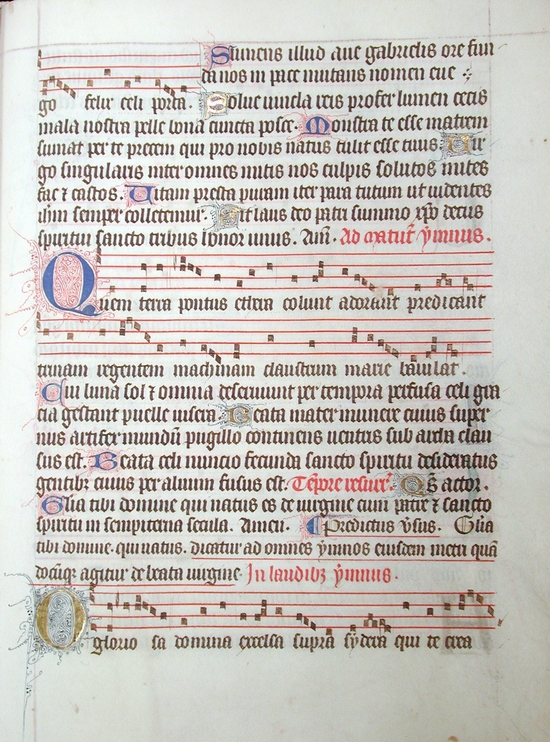In Eastertide (and only during Eastertide), the Vidi Aquam ("I saw water") chant replaces the Asperges Me ("Thou shalt sprinkle me, O Lord") during the asperges, the traditional sprinkling rite at the start of the mass, when the priest splashes the congregation with holy water. It is first sung as an antiphon at the Easter Vigil.
Here's an audio version of the Vidi Aquam, along with score; no word on who's singing.
From Fisheaters, here is the Latin text of Vidi Aquam:
Here it is in English:
The water used in the rite is a reminder of Baptism; the text referring to "water from the right side of the temple" comes from Ezekiel 47 - but is an obvious reference to spear-pierced side of Christ, and the water and blood that gushed from it. The second part of the Vidi Aquam "Praise the Lord, for He is good; for His mercy endureth forever" is from Psalm 118.
For comparison, here is the a video and the text of Asperges Me - the text which comes from Psalm 51 - in Latin and English:
Here's the chant score of Vidi Aquam, from the Liber Usualis:

Here's a baritone solo of the Vidi Aquam from the Liber:
Here's the Vidi Aquam as sung during the mass on the 3rd sunday after Easter at St. Andrew's Catholic Church in Edinburgh:
Here's an Ambrosian Chant version of the Vidi Aquam. This one uses different words than the Gregorian text above and is quite beautiful:
Here are all the chants for the Easter Vigil, from ChristusRex.org, and sung by the Sao Paulo Benedictines:
And here are posts on some of these at Chantblog:
Here's an audio version of the Vidi Aquam, along with score; no word on who's singing.
From Fisheaters, here is the Latin text of Vidi Aquam:
Vidi aquam egrediéntem de templo, a látere dextro, allelúia: et omnes ad quos pervénit aqua ista salvi facti sunt et dicent: allelúia, allelúia.
Confitémini Dómino, quóniam bonus: quóniam in sæculum misericórdia ejus.
P. Glória Patri, et Fílio, et Spirítui Sancto.
S. Sicut erat in princípio, et nunc, et semper, et in sæcula sæculórum. Amen.
Vidi aquam egrediéntem de templo, a látere dextro, allelúia: et omnes ad quos pervénit aqua ista salvi facti sunt et dicent: allelúia, allelúia.
Here it is in English:
I saw water flowing from the right side of the temple, alleluia; and all they to whom that water came were saved, and they shall say, alleluia, alleluia.
Praise the Lord, for He is good; for His mercy endureth forever. [Psalm 117].
P. Glory be to the Father, and to the Son, and to the Holy Ghost.
S. As it was in the beginning, is now, and ever shall be, world without end. Amen.
I saw water flowing from the right side of the temple, alleluia; and all they to whom that water came were saved, and they shall say, alleluia, alleluia.
The water used in the rite is a reminder of Baptism; the text referring to "water from the right side of the temple" comes from Ezekiel 47 - but is an obvious reference to spear-pierced side of Christ, and the water and blood that gushed from it. The second part of the Vidi Aquam "Praise the Lord, for He is good; for His mercy endureth forever" is from Psalm 118.
For comparison, here is the a video and the text of Asperges Me - the text which comes from Psalm 51 - in Latin and English:
Aspérges me. Dómine, hyssópo, et mundábor: lavábis me, et super nivem dealbábor.
Miserére mei, Deus, secúndum magnam misericórdiam tuam.
P. Glória Patri, et Fílio, et Spirítui Sancto.
S. Sicut erat in princípio, et nunc, et semper, et in sæcula sæculórum. Amen.
Aspérges me. Dómine, hyssópo, et mundábor: lavábis me, et super nivem dealbábor.
Thou shalt sprinkle me, O Lord, with hyssop, and I shall be cleansed; Thou shalt wash me, and I shall become whiter than snow.
Have mercy on me, O God, according to Thy great mercy. [Psalm 50]
P. Glory be to the Father, and to the Son, and to the Holy Ghost.
S. As it was in the beginning, is now, and ever shall be, world without end. Amen.
Thou shalt sprinkle me, O Lord, with hyssop, and I shall be cleansed; Thou shalt wash me, and I shall become whiter than snow.)
Here's the chant score of Vidi Aquam, from the Liber Usualis:

Here's a baritone solo of the Vidi Aquam from the Liber:
Here's the Vidi Aquam as sung during the mass on the 3rd sunday after Easter at St. Andrew's Catholic Church in Edinburgh:
Here's an Ambrosian Chant version of the Vidi Aquam. This one uses different words than the Gregorian text above and is quite beautiful:
Here are all the chants for the Easter Vigil, from ChristusRex.org, and sung by the Sao Paulo Benedictines:
Dominica Paschæ in Resurrectione Domini
Ad Vigiliam Paschalem in Nocte Santa
Lumen Christi (9.9s - 158 kb) score
Præconium Paschale (provisory mono files) Exsultet iam (2m16.2s - 400 kb) Per omnia (33.5s - 101 kb) Vere dignum (4m43.9s - 835 kb) In huius (1m42.2s - 303 kb) Oramus ergo (3m00.2s - 531 kb)
Ad liturgiam verbi - cantica post lectiones Canticum: Iubilate Domino (1m23.0s - 1298 kb) score
Canticum: Qui confidunt
Canticum: Cantemus Domino (2m12.9kb - 2078 kb) score
Canticum: Laudate Dominum
Canticum: Vinea facta est (1m40.0s - 1564 kb) score
Canticum: Attende cælum
Canticum: Sicut cervus (2m01.6s - 1902 kb) score
Alleluia: Confitemini Domino (3m15.1s - 3052 kb) score
Antiphona: Vidi aquam (1m29.4s - 1400 kb) score
Offertorium: Dextera Domini (1m36.7s - 1512 kb) score
Communio: Alleluia (1m11.9s - 1124 kb) score
Ite missa est (28.7s - 451 kb) score
And here are posts on some of these at Chantblog:
- Exsultet (or Exsultet!)
- The Easter Vigil: Alleluia!
- A Song for the Easter Vigil: Sicut Cervus
- Vidi Aquam
- The Easter Vigil Offertory: Dextera Domini



















